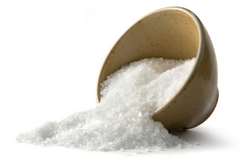
The dangerously high salt levels in processed food and fast food remain essentially unchanged, despite numerous calls from public and private health agencies for the food industry to voluntarily reduce sodium levels, reports a new Northwestern Medicine® study conducted with the Center for Science in the Public Interest.
The study, published May 13 in JAMA Internal Medicine, assessed the sodium content in selected processed foods and in fast-food restaurants in 2005, 2008, and 2011. The main finding was that the sodium content of food is as high as ever.
“The voluntary approach has failed,” said Stephen Havas, MD, MPH, corresponding author of the paper and a research professor of preventive medicine at Northwestern University Feinberg School of Medicine. “The study demonstrates that the food industry has been dragging its feet and making very few changes. This issue will not go away unless the government steps in to protect the public. The amount of sodium in our food supply needs to be regulated.”
Excess sodium prematurely kills as many as 150,000 people in the U.S. each year. About 90 percent of the U.S. population develops high blood pressure, and high salt in the diet is a major cause. High blood pressure increases the risk of developing heart attacks and strokes, often resulting in death or disability.
“High salt content in food benefits the food industry,” Havas said. “High salt masks the flavor of ingredients that are often not the best quality and also stimulates people to drink more soda and alcohol, which the industry profits from.”
A typical American consumes an average of almost two teaspoons a day of salt, vastly higher than the recommended amount of three-fifths of a teaspoon, or no more than 1,500 milligrams, as recommended by the American Heart Association. About 80 percent of our daily sodium consumption comes from eating processed or restaurant foods. Very little comes from salt we add to food.
“The only way for most people to meet the current sodium recommendation is to cook from scratch and not use salt,” Havas said. “But that’s not realistic for most people.”
The FDA needs to begin regulating food processors and the restaurant industry – as has been recommended by the Institute of Medicine and others – as soon as possible, Havas said. He also noted that our taste buds rapidly adapt to less salt.
“If it’s reduced by 20 percent a year, no one would know the difference,” he said.
The study found that between 2005 and 2011, the sodium content in 402 processed foods declined by approximately 3.5 percent, while the sodium content in 78 fast-food restaurant products increased by 2.6 percent. Although some products showed decreases of at least 30 percent, a greater number of products showed increases of at least 30 percent. The predominant finding was the absence of any appreciable or statistically significant changes in sodium content during six years.






